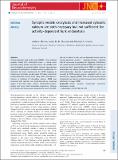Files in this item
Synaptic vesicle exocytosis and increased cytosolic calcium are both necessary but not sufficient for activity-dependent bulk endocytosis
Item metadata
| dc.contributor.author | Morton, Andrew | |
| dc.contributor.author | Marland, Jamie R K | |
| dc.contributor.author | Cousin, Michael A | |
| dc.date.accessioned | 2015-12-02T11:40:07Z | |
| dc.date.available | 2015-12-02T11:40:07Z | |
| dc.date.issued | 2015-08 | |
| dc.identifier | 184104423 | |
| dc.identifier | f0d88c65-ae65-4f28-8813-3a8e6dd9754a | |
| dc.identifier | 25913068 | |
| dc.identifier | 84935418154 | |
| dc.identifier.citation | Morton , A , Marland , J R K & Cousin , M A 2015 , ' Synaptic vesicle exocytosis and increased cytosolic calcium are both necessary but not sufficient for activity-dependent bulk endocytosis ' , Journal of Neurochemistry , vol. 134 , no. 3 , pp. 405-415 . https://doi.org/10.1111/jnc.13132 | en |
| dc.identifier.issn | 0022-3042 | |
| dc.identifier.uri | https://hdl.handle.net/10023/7879 | |
| dc.description | This work was supported by the Medical Research Council [Grant number: G1002117] and a PhD studentship from the Biotechnology and Biological Sciences Research Council. | en |
| dc.description.abstract | Activity-dependent bulk endocytosis (ADBE) is the dominant synaptic vesicle (SV) endocytosis mode in central nerve terminals during intense neuronal activity. By definition, this mode is triggered by neuronal activity; however, key questions regarding its mechanism of activation remain unaddressed. To determine the basic requirements for ADBE triggering in central nerve terminals, we decoupled SV fusion events from activity-dependent calcium influx using either clostridial neurotoxins or buffering of intracellular calcium. ADBE was monitored both optically and morphologically by observing uptake of the fluid phase markers tetramethylrhodamine-dextran and horse radish peroxidase respectively. Ablation of SV fusion with tetanus toxin resulted in the arrest of ADBE, but had no effect on other calcium-dependent events such as activity-dependent dynamin I dephosphorylation, indicating that SV exocytosis is necessary for triggering. Furthermore, the calcium chelator EGTA abolished ADBE while leaving SV exocytosis intact, demonstrating that ADBE is triggered by intracellular free calcium increases outside the active zone. Activity-dependent dynamin I dephosphorylation was also arrested in EGTA-treated neurons, consistent with its proposed role in triggering ADBE. Thus SV fusion and increased cytoplasmic free calcium are both necessary but not sufficient individually to trigger ADBE. This article is protected by copyright. All rights reserved. | |
| dc.format.extent | 11 | |
| dc.format.extent | 1518217 | |
| dc.language.iso | eng | |
| dc.relation.ispartof | Journal of Neurochemistry | en |
| dc.subject | Calcium | en |
| dc.subject | Dynamin | en |
| dc.subject | Endocytosis | en |
| dc.subject | Exocytosis | en |
| dc.subject | Presynapse | en |
| dc.subject | Vesicle | en |
| dc.subject | RC0321 Neuroscience. Biological psychiatry. Neuropsychiatry | en |
| dc.subject | QD Chemistry | en |
| dc.subject | NDAS | en |
| dc.subject.lcc | RC0321 | en |
| dc.subject.lcc | QD | en |
| dc.title | Synaptic vesicle exocytosis and increased cytosolic calcium are both necessary but not sufficient for activity-dependent bulk endocytosis | en |
| dc.type | Journal article | en |
| dc.contributor.institution | University of St Andrews. School of Physics and Astronomy | en |
| dc.identifier.doi | https://doi.org/10.1111/jnc.13132 | |
| dc.description.status | Peer reviewed | en |
This item appears in the following Collection(s)
Items in the St Andrews Research Repository are protected by copyright, with all rights reserved, unless otherwise indicated.

